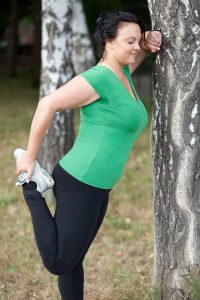12.2 Flexibility Defined
Flexibility and range of motion are important for overall daily functioning and physical health. Flexibility refers to the ability to move joints through their full range of motion, which is important for maintaining normal body posture and function. Flexibility is specific to each joint and impacted by genetics and individual joint structure, which aren’t really modifiable. Fortunately, though, flexibility is also determined by muscle elasticity and length, which can be modified through stretching to improve range of motion.
Comparing and Contrasting Various Types of Stretching
According to the American College of Sports Medicine, various types of stretching—static, dynamic, proprioceptive neuromuscular facilitation, and ballistic stretches—are effective (Garber et al., 2011). However, different types are recommended for different situations and fitness levels.
PNF Stretching
Proprioceptive neuromuscular facilitation—or PNF stretching—involves contracting the muscle while holding a stretch for a targeted muscle. For example, an individual might stretch their hamstring muscle by lying on their back and pulling a straight leg up through the air and back as far as they can, holding the stretch for about ten seconds. Then they will contract that muscle as forcefully as they can by pushing it against an immovable object like a partner’s shoulder, a wall, or a pole for five seconds. After this contraction, they will pull the leg back into the stretch again for another ten seconds. PNF stretching is safe for all fitness levels but should be done post-workout. Warm muscles accept stretch better than cold muscles, and stretching cold muscles can increase the risk of injury.
Static Stretching

Static stretching involves slowly stretching a muscle to the point of feeling a slight pull or mild discomfort—but not to a point of feeling sharp pain—holding the stretch for 10-30 seconds, releasing and resting for 30-60 seconds, and repeating two to four times to an accumulation of 60 seconds per stretch, trying to stretch a bit further each time. A quadricep stretch, for example, involves pulling the foot behind you up to the buttocks or as far as it will go to feel a pull and holding. Remember that while it may feel a bit uncomfortable at first, it shouldn’t hurt. If it hurts, then you’re probably stretching too far. It is important to breathe throughout each stretch and avoid bouncing or forcing the stretch. When possible, include a variety of exercises that stretch the muscles associated with all of the body’s major joints and perform each exercise on both sides of the body. While there is mixed research about the best time to perform static stretching it is generally recommended as part of a post-workout or cool down routine.
Ballistic Stretching
Ballistic stretching is recommended only for well-conditioned, high-level athletes because it involves quick, specific movements through a joint’s range of motion and even bouncing. One example of a ballistic stretch—sometimes referred to as a butterfly stretch—involves sitting on the ground with the soles of the feet touching each other and the knees out, then bouncing the knees up and down. It can be beneficial prior to competing in an athletic event, but is associated with a higher risk of injury compared to other types of stretching because it’s pushing the muscle slightly beyond its natural range of motion.
Dynamic Stretching
Dynamic stretching is similar to ballistic stretching, as it involves movement through a joint’s range of motion, but slower and without the bouncing. It is generally recommended as part of a warm-up and can utilize stretches that mimic the movements of the sport or activity you are about to participate in. An example of a dynamic stretch is arm circles—holding both arms straight out from the body and moving them in wide circles to warm up the shoulder muscles.
Self-Assess Your Understanding
- Define flexibility.
- Distinguish between various types of stretching exercises.
refers to the ability to move joints through their full range of motion; flexibility is specific to each joint and impacted by genetics and individual joint structure, which aren’t really modifiable.
also known as PNF stretching—involves contracting the muscle while holding a stretch for a targeted muscle. Example: stretching the hamstring muscle while laying on your back by pulling a straight leg up through the air and back as far as you can, holding the stretch for about ten seconds
involves slowly stretching a muscle to the point of feeling a slight pull or mild discomfort, holding the stretch for 10-30 seconds, releasing and resting for 30-60 seconds, and repeating two to four times to an accumulation of 60 seconds per stretch, trying to stretch a bit further each time
recommended only for well-conditioned, high-level athletes because it involves quick, specific movements through a joint’s range of motion and even bouncing.
similar to ballistic stretching as it involves movement through a joint’s range of motion, but slower and without the bouncing. Example: arm circles—holding both arms straight out from the body and moving them in wide circles to warm up the shoulder muscles.

